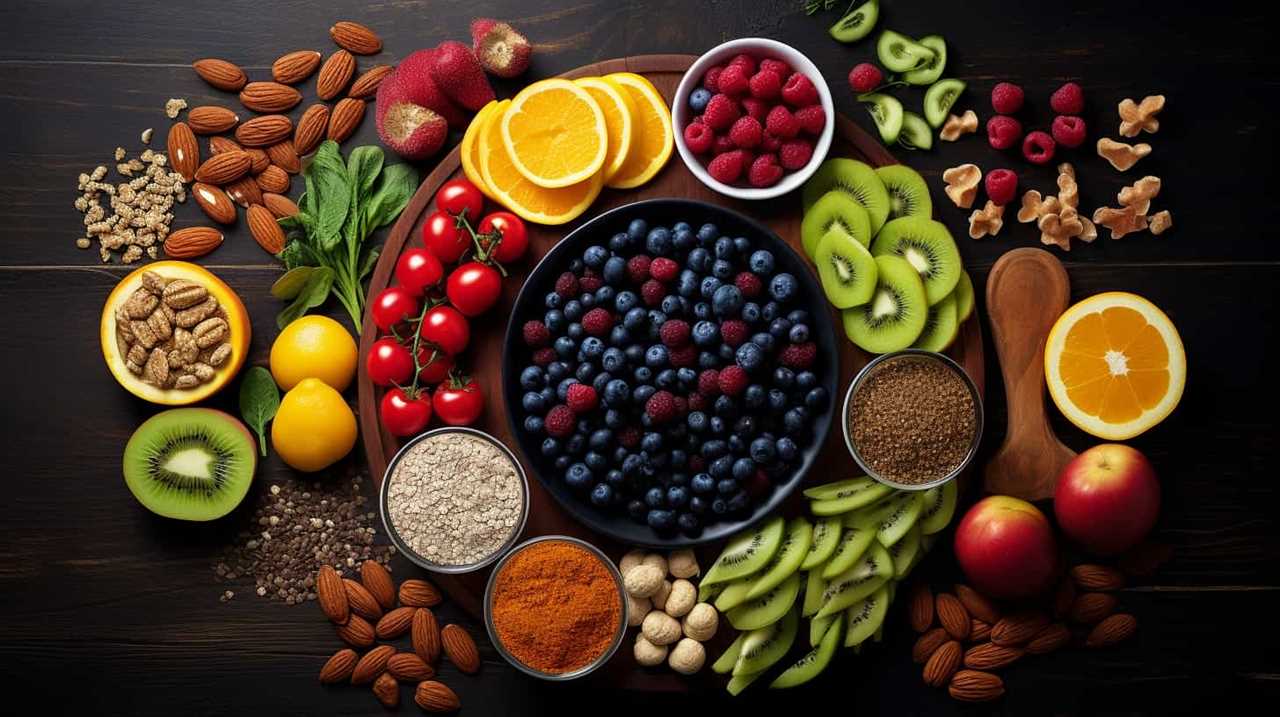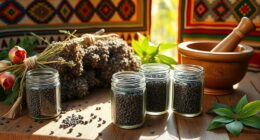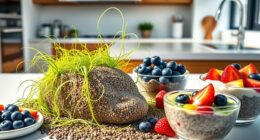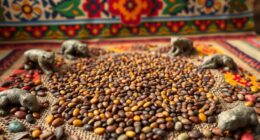
We provide the genuine guidance necessary for successfully growing chia seeds.
Did you know that chia seeds are packed with nutrients and have been used for centuries?
In this article, we’ll guide you through the process of choosing the right soil, providing adequate sunlight, watering dos and don’ts, fertilizing for optimal growth, and harvesting and storing chia seeds correctly.
Get ready to serve yourself and others with a bountiful chia harvest!

Key Takeaways
- Use high-quality, well-draining soil that is rich in nutrients for optimal growth.
- Choose a pot with good drainage holes that is at least 6 inches deep for root growth.
- Provide chia plants with 6-8 hours of direct sunlight per day, while also protecting them from excessive heat.
- Water chia seeds regularly to keep the soil consistently moist, but avoid overwatering to prevent rotting and fungal diseases.
Choosing the Right Soil for Chia Seeds
We recommend using a high-quality, well-draining soil for optimal growth of chia seeds. Choosing the right soil is crucial in ensuring the success of your chia plants.
Chia seeds require a soil that’s rich in nutrients, yet well-draining to prevent waterlogging and root rot. A pot with good drainage holes is also essential to maintain the right moisture levels and prevent water stagnation.
It’s recommended to use a pot that’s at least 6 inches deep to allow the roots to grow freely.
Additionally, it’s important to be aware of common pests and diseases that can affect chia plants. Aphids, spider mites, and powdery mildew are some of the common pests and diseases that can impact chia plants.

Regular monitoring, proper hygiene practices, and the use of organic pest control methods can help prevent and manage these issues.
Providing Adequate Sunlight for Chia Plants
To ensure optimal growth of chia plants, it’s essential to provide them with adequate sunlight. Chia plants are sun-loving plants that require at least 6-8 hours of direct sunlight per day. Maximizing chia plant growth requires placing them in a location that receives ample sunlight throughout the day. This will provide the plants with the energy they need for photosynthesis, which is crucial for their growth and development.
However, it’s important to prevent sun damage to the chia plants. Excessive exposure to intense sunlight can lead to wilting, leaf burn, and stunted growth. To mitigate this, it’s recommended to provide some shade during the hottest part of the day, especially in regions with scorching temperatures. This can be achieved by using shade cloth or positioning the plants in areas where they receive partial shade during the peak hours of sunlight.
Watering Chia Seeds: Dos and Don’ts
Watering chia seeds effectively is crucial for their growth and development. To ensure the best results, it’s important to maintain proper moisture levels and avoid overwatering. Here are some dos and don’ts for watering chia seeds:

-
Do: Water chia seeds regularly, keeping the soil consistently moist but not waterlogged.
-
Do: Use a spray bottle or misting system to provide gentle and even watering.
-
Don’t: Allow the soil to dry out completely between waterings, as chia seeds require consistent moisture for germination and growth.
-
Don’t: Overwater chia seeds, as excessive moisture can lead to rotting and fungal diseases.

Fertilizing Chia Plants for Optimal Growth
After ensuring proper watering, it’s important to address the fertilization needs of chia plants for optimal growth.
Organic fertilizers play a vital role in providing essential nutrients to chia plants in a natural and sustainable manner. These fertilizers are derived from natural sources such as compost, animal manure, and plant-based materials. They contain a balanced blend of nitrogen, phosphorus, and potassium, which are crucial for chia plant development. Additionally, organic fertilizers enhance soil fertility, improve water retention, and promote beneficial microbial activity. This helps chia plants to absorb nutrients efficiently, leading to healthier growth and higher yields.
Furthermore, natural pest control methods should be incorporated to protect chia plants from harmful insects and diseases. This can be achieved through the use of beneficial insects, companion planting, and organic pest repellents.
Harvesting and Storing Chia Seeds Correctly
Once we’ve ensured that our chia plants are fertilized properly, it’s crucial to understand how to harvest and store chia seeds correctly. Proper chia seed storage is essential to maintain their quality and prevent the formation of mold, which can render them unusable.

Here are some key points to consider:
-
Harvesting: Chia seeds are ready for harvest when the flowers have dried and the seed heads have turned brown. Cut the seed heads and place them in a paper bag to collect the seeds.
-
Drying: Spread the harvested seeds in a single layer on a clean, dry surface. Allow them to dry completely before storing.
-
Storage container: Use airtight containers such as glass jars or sealed plastic bags to store chia seeds. This will protect them from moisture and pests.

-
Storage conditions: Store chia seeds in a cool, dark, and dry place to prolong their shelf life and prevent mold formation.
Frequently Asked Questions
How Long Does It Take for Chia Seeds to Germinate?
Chia seeds typically take about 7-14 days to germinate. The chia seed germination process involves soaking the seeds in water, providing consistent moisture and temperature, and ensuring proper drainage for optimal growth.
Can Chia Seeds Be Grown Indoors?
Yes, chia seeds can be successfully grown indoors. To ensure successful germination, provide them with a warm and well-lit environment, maintain consistent moisture levels, and use quality potting soil.
Is It Necessary to Soak Chia Seeds Before Planting?
Soaking chia seeds before planting is necessary to promote germination and ensure successful growth. It helps to soften the seed coat, allowing water to penetrate and initiate the sprouting process. Proper planting techniques are crucial for optimal chia seed cultivation.

What Is the Ideal Temperature Range for Chia Seed Germination?
The ideal temperature range for chia seed germination is between 70-85 degrees Fahrenheit. Soaking chia seeds before planting has numerous benefits, including faster germination and improved nutrient absorption.
Can Chia Plants Tolerate Frost or Cold Temperatures?
Chia plants have limited frost tolerance and struggle to survive in cold temperatures. Consequently, it is important to provide proper protection and ensure the plants are shielded from freezing conditions to promote successful growth.
Conclusion
In conclusion, by following these genuine tips for growing chia seeds, one can ensure optimal growth and harvest.
Just like a well-oiled machine, providing the right soil, adequate sunlight, proper watering, and appropriate fertilization will yield healthy chia plants.

Remember, harvesting and storing chia seeds correctly is crucial for preserving their nutritional value, like a treasure chest preserving its precious jewels.
So, embark on this scientific journey and watch your chia seeds flourish, like a symphony of nature’s wonders.








